 |
A S-89 Supermarine Spitfire LF Mark IXE fighter plane assigned to the former Cz Nos 310-313 Sqns bearing the „Day Fighter Scheme“ of the British camouflage pattern ie.irregular strips of Ocean Grey and Dark Green on the upper surfaces and Medium Sea Grey on the lower ones.The fighter pool of Cz AF comprised 68 brand new Spitfires LF Mk IX E, 24 USSSR-made La 5 FN and 54 La 7 types aircraft on July 11, 1946.
|
| |
|
|
S-89 Supermarine Spitfire LF Mk IXE, where the „LF “ stands for „low flying„. All-metal construction, top speed of 646km.p.h., range 690 km and service ceiling 12 900 metres. Powerplant a 1580 Rolls Royce Merlin 66, empty weight 2630 kg. Armament two 20 mm-cal cannons and two 0.5 machine guns. Span 9.93, length 9.54 m. Aerobatics performed by a former No 312 Sqn`s fighter pilot Karel Posta in his all-in-silver machine was a high mark of each post-war Air Show – eg on Sep 15, 1946 and Sep 7, 1947.
|
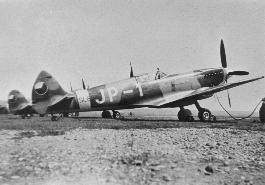 |
| |
|
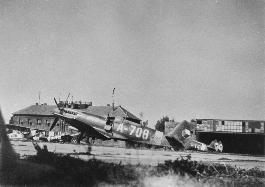 |
More than 70 S-89 Supermarine Spitfire LF Mk IXE s were bought on the V-E Day by the Cz Gvt. 54 of them landed on the Prague Ruzyne Airport on August 13, 1945. The top quality of the Cz AF fighter pool was formed by this type. After the Febr 25, 1948 Communist Coup these machines were discharged and replaced by the S-199 fighter planes of lower quality. 59 airworthy Spits were sold to Israel.
|
| |
|
|
S-89 Supermarine Spitfire LF Mk IXEs of the former Cz Nos 310, 312-313 Sqns were assigned to Nos 1-3 Air Divisions set up on Oct 28, 1945. During 1947 most S-89s were handed over to the Military Air Academy and the Fighter Training Center. Flying the Spits, the total amount of 27 mishaps occured claiming lives of : F/O Josef Sokol on Jun 17, 1946, S/Ldr František Truhlar near his native village on Dec 3, 1946, F/O Vaclav Truhlar on Oct 10, 1947, a pilot pupil Zdenek Sticha on Oct 31, 1947 and W/O Richard Nerger on Dec 2,1947. F/Lt Vladimír Kopecek was severely wounded on Sep 26, 1946.
|
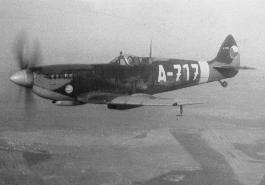 |
| |
|
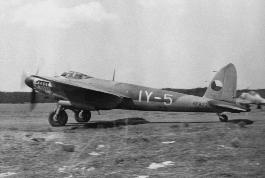 |
B-36 De Havilland Mosquito F. B. Mk VI , where the letters F.B. stand for Fast Bomber. Powered by two Merlin 25 engines of 1203 hp each driving three-blade composite fully articulated propellers, top speed of 610 km.p.h. B-36s of the Cz AF were used as a bomber, heavy fighter as well as a ground attack aircraft. Four 20mm-cal cannons were later replaced for MG 151of German origin. Except one all-silver CO`s machine and two bright yellow training ones all the others B-36s bore the standard camouflage pattern of the RAF – irregular strips of Ocean Grey and Dark Green on the upper surfaces and the same shade of Grey on the lower ones.
|
| |
|
|
B-36 DH Mosquito F. B. Mk VI – Span 16. 52 m, length 12,30 m, empty weight 6 492 kg, attaining a range of 1940 km and service ceiling 10 000 m.Wooden framed wings and tailplane covered by plywood, metal framed rudder and elevator was fabric-covered. Plywood-moulded fuselage. A tailwheel retracted into a hull, main undercarriage members into engine nacelles.Service-span was severely influenced by using plywood and wood in B-36s compared with all-metal Spits.
|
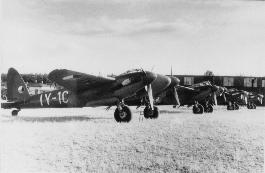 |
| |
|
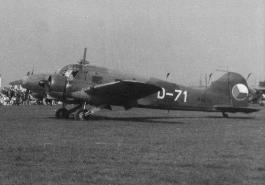 |
D-41 Avro Ansons were used for submarine patrols as well as supply duties and advanced training of bomber pilots. Powered by two Armstrong Siddeley Cheetah engines of 335 hp each, top speed of 300 km.p.h, range 1060 km and service ceiling 5 600 m. Span 17.20 m, legth 12.90 m, empty weight 2 440 kg, steel-tube welded fuselage covered by fabric, wood-framed wings, fin and tailplane covered by plywood, steel-framed elevator and rudder covered by fabric.Tail wheel fixed.
|
| |
|
|
S-92 Messerschmitt Me 262. Because Luftwaffe pilots succeeded in flying all the airworthy Me 262s to the zone occupied by the Americans early May 1945, every airframe found on the Czech territory after V-E Day had to undergo reconstruction in the Avia Letnany plant. The first airframe was ready for fitting engines in autumn 1945. The first S-92 with the Avia Company`s test pilot Antonin Kraus at the controls got aloft on August 27, 1946. But the S-92 concept proved to be outdated at that time already.
|
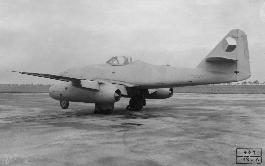 |
| |
|
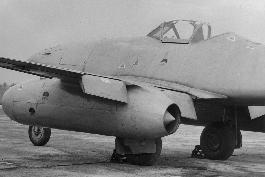 |
S-92.Czech-built Messesschmitt 262s powered by two 8.80 kN-thrust Juno 004 engines attained the maximum speed of 870 km.p.h. This type was able to one-engine-fly if being at state of emergency. Range 1050 km, service ceiling 11000 m. The underslung engines were housed in nacelles. Both undercarriage struts were detracted towards a hull,a nose wheel backwards. Alclad all-metal airframe.
|
| |
|
|
A Me 262 and a MIG-15 in the foreground, designed by a Soviet Mikoyan-Guryevich`s designer staff and licensed-built in the Czechoslovakia coded S-102 and a double seat version MIG 15 bis as the S-103 one. Span 10.08 m, length 10.10 m, empty weight 3 382 kg, powered by a 22.30 kN-thrust RD-45F engine. Top speed 1070 km.p.h.,service ceiling 15 200 m, range 1 600 km. Armed by two 23 mmm-cal and one of 37 mm-cal cannons mounted in the nose. Alclad skinning of the fuselage of duralmin-semicircular-moulded construction, as well as steel-framed wings, tailplane, rudder and elevator. undercarriage retracted the same way as in the Me-262 type.
|
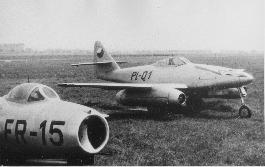 |
| |
|
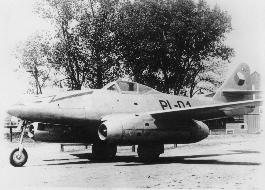 |
S-92 Me 262 nicknamed Schwalbe ie Dove was a type with the dimensions as follows : span 12.51 m, length 10.60 m and empty weight of 4 420 kg. Armed by two or four nose-mounted 30 mm-cal cannons, but most of S-92s were flown without them. The all-in –silver PL-01 machine with a red arrow had never got aloft because it was used in the Fighter Pilot Training Center. All the other machines of this type bore the camouflage of a mixture of gray green.
|
| |
|
|
S-99 Messeschmitt Me 109 of G- and K versions were the most commonly used fighter planes flown in the Czechoslovakia after the end of hostilities. Twenty one Bf 109s were overhauled in the Avia Comp and coded S-99. Span 9.92 m, length 8.94 m, empty weight 2 520 kg. Powered by a 1 430 hp Daimler Benz engine, top speed of 600 km.p.h. Two synchronized machine guns and a through-the propeller-axle shooting cannon. Three blades of the propeller fully articulated. Undercarriage members retracted towards wingtips, a tailwheel fixed. A steel-framed fuselage and wings fabric-covered, wooden frame of a fin and a tailplane covered by plywood, an elevator and rudder fabric-covered.
|
 |
| |
|